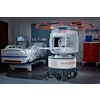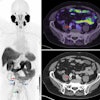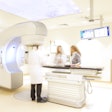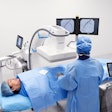
We live in turbulent, but exciting, times. People are liberating themselves from their tyrants, stock markets are showing manic-depressive behavior, and countries are on the verge of bankruptcy. In the meantime, the global scientific community is connected through the Internet; it has never been easier to exchange information; and new technologies are being introduced in our lives with unprecedented speed.
The radiology profession is changing rapidly too. In less than a decade, most of us have switched from film to fully digital with PACS. The combination with high-speed broadband has created real fireworks. Not only has it become possible to organize our work much more efficiently, but also the immediate availability of the rich ingredients of the Internet has allowed us to put the real icing on the cake: improvement of our radiology reports.
 Dr. Erik Ranschaert is a radiologist at Jeroen Bosch Ziekenhuis, 's-Hertogenbosch, the Netherlands.
Dr. Erik Ranschaert is a radiologist at Jeroen Bosch Ziekenhuis, 's-Hertogenbosch, the Netherlands.
Nowadays we even carry this infinite resource of information in our pockets and reach it with the simple touch of a finger. In this new digital environment, images are never far away from us, which creates an enormous opportunity to improve the way we communicate with clinicians and patients.
In the background, the financial world is going into crisis. Increasing healthcare costs and the simultaneous shrinking of public healthcare budgets are leading to various cost-effective techniques in providing healthcare. What will be the future role of teleradiology in Europe?
Magic formula vs. apprehensions
Teleradiology is an integral part of the e-Health Agenda in Europe, since it has the potential for cost reduction and productivity gains. Telemedicine is regarded as a magic formula to fix overstretched healthcare systems. Does this mean teleradiology is finally going to make its breakthrough in the European market?
Some people still have some apprehensions about teleradiology. Many decision-makers at the regional or healthcare institution level are still reluctant to accept the change in the information sharing paradigm. Apparently the mind-set of many is changing more slowly than changes in technology. Dr. George McInnes correctly described these so-called "myths" of teleradiology in his guest column. Local governments and professional organizations have tried to put all sorts of brakes on teleradiology. German, French, and Swiss images cannot be interpreted outside of the country. "The danger is that if we start dismantling this protection then all the business will go to India," is often heard.
Another concern is that the act of outsourcing radiological examinations reduces radiology to a tradable "commodity," whereas it should be regarded as a real "medical act," which encompasses a lot more than only reading images. Dr. Lluis Donoso, member of the Executive Council of the European Society of Radiology (ESR) already made a clear statement about this saying that "teleradiology is not equivalent to tele-reporting radiological images, but it is a medical act in its own right."
How should these remaining obstacles be dealt with, what needs to happen for teleradiology to gain the trust of the decision-makers, hospital managers and -- last but not least -- to convince the radiologists themselves?
Quality and trust
Undeniably, important issues still need to be solved on the technical side (integration of IT systems, implementation of Integrating the Healthcare Enterprise [IHE] protocols for sharing of workflows), and the legal level (especially for the cross-border teleradiology). However, these matters are less directly part of the radiologist's tasks . In addition, further standardization of techniques and clarification of legal issues are both on the agenda of the European authorities. This also shows that teleradiology is very likely to become an integral part of healthcare delivery across Europe. The language issue remains a very important problem that needs to be countered to facilitate cross-border teleradiology. It could be solved by creating and accepting universal semantics and nomenclatures, and further developing structured (multilingual) reports.
In my opinion, the solution lies in quality and trust. Quality should always have top priority, meaning the best possible diagnosis for the best possible price. There also needs to be a basis of trust between the collaborating parties, which of course also comes with the delivery of quality.
First of all, teleradiology will become a necessity for radiology departments if they want to adhere to the vision that quality can only be guaranteed by further subspecialization in radiology. This vision has been promoted by the ESR and is now quickly gaining field in most practices. The increased number of imaging procedures and advances in subspecialty reading needs will make it very difficult for radiologists to completely fulfill patient demands without the assistance of teleradiology.
Dr. Jörg Debatin, an expert in radiology and hospital management, calculated that a 1,200-bed hospital would need at least 24 radiologists to cover all possible sections. Debatin, who is medical director and chairman of the executive board of the Hamburg-Eppendorf University Clinic in Germany, thinks quality also means that the department offers a 24/7 diagnostic service by competent specialists. To achieve this, a strategic cooperation and networking between different hospitals is necessary (national and international). This collaboration also needs also to be built upon trust between the radiologists. Teleradiology is the only way to organize subspecialized image interpretation -- diagnostic radiology will eventually be handled in a "global reading room," he stated during a 6 March 2010 ECR presentation about Hospital Management. To sum up, the future of successful radiology is subspecialized knowledge on the highest level combined with efficient processes, which is where teleradiology offers entirely new perspectives and possibilities.
Furthermore, quality monitoring of all teleradiology providers should be organized in a transparent way, on a pan-European level. For most commercial providers, it is already current practice to include quality monitoring systems in their contracts. Good clinical governance, including regular audits and assessment procedures, should become standard and maybe even legally required for all teleradiology providers, even in hospitals, for cross-enterprise and cross-border teleradiology services to become widely accepted. EU-funded experiments with many-to-many connections such as the R-bay project (eMarketplace) have already been setup to enable such quality monitoring and transparency, and have showed that it can be achieved. Some teleradiology providers nowadays offer sophisticated platforms with built-in quality assurance tools, such as the ability to proactively monitor reporting trends of participating radiologists.
Support from the ESR could be given to set up guidelines for a European teleradiology accreditation system that can be used by the local organizations of each member state. The ESR could certainly also contribute in the acceptance of EU-wide semantics and the development of internationally accepted structural reporting models. In addition, organization of an ESR-teleradiology training with certification would certainly be a step in the good direction. Obtaining such a certificate could, for example, become a prerequisite to perform cross-border teleradiology within the EU, and probably would be helpful in making the necessary mind switch, which is mainly based upon trust in this technique.
Conclusion
It's a very interesting time to be working in radiology. No matter what happens to the economy, the digital imaging needs of patients are not going away, and they cannot be ignored. In spite of the apprehension, teleradiology is here to stay and should be considered as the future of healthcare delivery. Nevertheless, some issues still need to be addressed. The quality aspect of teleradiology is of major importance to ensure further successful deployment of cross-enterprise and cross-border image-sharing platforms.
A clear regulatory framework is required that recognizes that cross-border teleradiology exists and that addresses legitimate quality concerns. Such a framework will prevent the work drifting to lower wage economies while benefiting from the expertise of radiologists across Europe and further afield. There is also an obvious role for the ESR in giving further guidance in solving the quality issue and in enhancing the trust in this technique.
[Note: Dr. Ranschaert and Dr. Frits Barneveld Binkhuysen, past president of the Radiological Society of the Netherlands, are currently conducting a survey into teleradiology in Europe. They are working in collaboration with the ESR and the survey may be found here or on the ESR's hompage as well as on the ESR facebook page.]
Dr. Erik Ranschaert is a radiologist at Jeroen Bosch Ziekenhuis, 's-Hertogenbosch, the Netherlands. He was also one of the founders ofa Belgian teleradiology company called Eurad Consult, now known as Unilabs Teleradiology, which he's no longer a part of. At the next ECR he will present a session on teleradiology.
The comments and observations expressed herein do not necessarily reflect the opinions of AuntMinnieEurope.com, nor should they be construed as an endorsement or admonishment of any particular vendor, analyst, industry consultant, or consulting group.



















